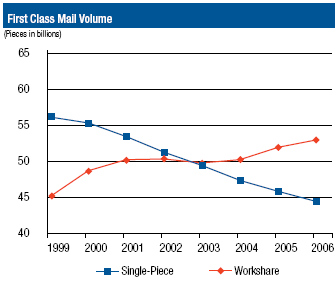 |
page 26 of 66 |  |
Financial Section Part II
Standard Mail volume exceeded First-Class Mail volume for the second consecutive year. Standard Mail's volume growth in 2006 was the slowest since 2002, when advertising expenditures declined throughout the economy as a result of a recession. The softness in Standard Mail volume growth is attributable to lackluster growth in Standard Regular Mail of 1.5% as well as a decline of 13.4% in Nonprofit Enhanced Carrier Route Mail. Despite these weaknesses, Standard Mail continues to hold its ground in the advertising market by virtue of its two dominant characteristics; it can be targeted to specific audiences, and its effectiveness can be measured by the customer.

As shown on the chart above the change in mail mix has a large impact on our revenue. If the mail mix had remained the way it was in 2001 we would have had an estimated additional $2.5 billion in revenue in 2006.
First-Class Mail volume, our largest mail class until 2005, decreased slightly in 2006, declining for the third time in the last four years. An increase of 1,075 million pieces or 2.1% in workshare First-Class letters partially offset the continuing decline in single-piece volume, which was down 1,529 million pieces or 3.3%. The long-term continued decline in single-piece volume reflects the impact of electronic diversion as businesses, nonprofit organizations, governments, and households increasingly automate transactions and divert correspondence to the Internet. Consolidation in the pre-bar-coded mailer market suggests that some of the single-piece First-Class Mail may be migrating to workshare
First-Class Mail. Although workshare First-Class Mail volume increased in 2006, the growth rate was less than half the growth rate in 2005. Workshare letters are also affected by electronic diversion, but to a lesser extent. A slowdown in credit card solicitations may have put added downward pressure on workshare letter growth.

For the second year in a row, Priority Mail volume increased. The 4.1% growth rate was especially encouraging in light of the January rate increase since demand for Priority Mail is relatively price sensitive. Four factors continue to drive this performance. First, we have worked to consistently improve Priority Mail service performance. Second, Priority Mail is increasingly easy to use. Customers can purchase postage and print mailing labels with free delivery confirmation through Click-N-Ship at http://www.USPS.com/onlinepostage/ or on commercial websites. Carrier pickup saves customers a trip to the Post Office and our flat rate envelope and flat rate boxes simplify Priority Mail use further. Third, prior to the January 8, 2006 rate increase, Priority Mail rates had not changed since June 2002, while our competitors’ published rates have increased almost annually during the same period. Finally, the increase in our competitors’ surcharges for fuel, residential delivery, and delivery in rural areas make Priority Mail a cost effective choice.
We continue to develop new Priority Mail products such as Priority Mail flat-rate boxes which allow customers to send Priority Mail at a flat rate price of $8.10 regardless of the weight of the box. Originally launched in November 2004 with two different shaped boxes, in 2006 we added a Priority Mail shoebox.
Express Mail volume increased 475,000 pieces over 2005, and like Priority Mail, Express Mail had benefited from continued rate stability, and the impact of surcharges imposed by private sector competitors, as well as website access on www.USPS.com. This is the second consecutive year of volume increases for Express Mail after four years of declines.